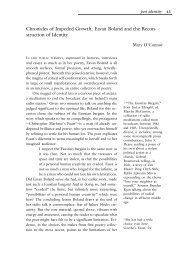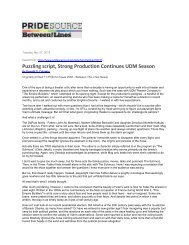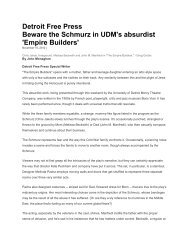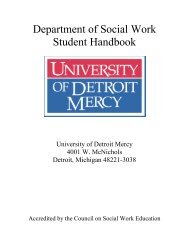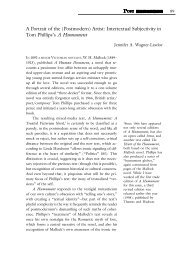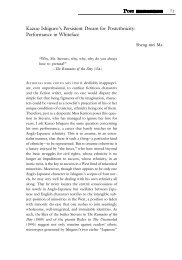Conquest, Conversion, and the Hybrid Self in Cabeza de Vaca's ...
Conquest, Conversion, and the Hybrid Self in Cabeza de Vaca's ...
Conquest, Conversion, and the Hybrid Self in Cabeza de Vaca's ...
Create successful ePaper yourself
Turn your PDF publications into a flip-book with our unique Google optimized e-Paper software.
136 POST OST IDENTITY<br />
IDENTITY<br />
several <strong>in</strong>ci<strong>de</strong>nts <strong>in</strong> which <strong>the</strong> natives ask him <strong>and</strong> his party<br />
to remedy <strong>the</strong>ir illnesses. They have great success <strong>in</strong> cur<strong>in</strong>g<br />
<strong>the</strong> natives of “great pa<strong>in</strong> <strong>in</strong> <strong>the</strong> head,” of cramps, <strong>and</strong><br />
even, on one remarkable occasion, of “<strong>de</strong>ath” (117, 120–<br />
2). This last example <strong>de</strong>serves close exam<strong>in</strong>ation. <strong>Cabeza</strong><br />
<strong>de</strong> Vaca is taken to a hut where he f<strong>in</strong>ds “that <strong>the</strong> sick man<br />
we went to heal was <strong>de</strong>ad.” The natives also believe he is<br />
<strong>de</strong>ad: as <strong>Cabeza</strong> <strong>de</strong> Vaca expla<strong>in</strong>s, “Many persons were<br />
around him weep<strong>in</strong>g, <strong>and</strong> his house was prostrate, a sign<br />
that <strong>the</strong> one who dwelt <strong>in</strong> it is no more.” Although he<br />
f<strong>in</strong>ds <strong>the</strong> man’s “eyes rolled up, <strong>and</strong> <strong>the</strong> pulse gone,” <strong>and</strong><br />
“hav<strong>in</strong>g all <strong>the</strong> appearances of <strong>de</strong>ath,” <strong>Cabeza</strong> <strong>de</strong> Vaca,<br />
never<strong>the</strong>less, says he “supplicated our Lord as fervently as<br />
I could,” blessed him <strong>and</strong> brea<strong>the</strong>d upon him, <strong>and</strong> <strong>the</strong>n<br />
left to treat many o<strong>the</strong>rs who were ill. Later than even<strong>in</strong>g,<br />
as <strong>Cabeza</strong> <strong>de</strong> Vaca expla<strong>in</strong>s, <strong>the</strong> natives reported to him<br />
that “he who had been <strong>de</strong>ad <strong>and</strong> for whom I wrought<br />
before <strong>the</strong>m, had got up whole <strong>and</strong> walked, had eaten <strong>and</strong><br />
spoken with <strong>the</strong>m, <strong>and</strong> that to all whom I had m<strong>in</strong>istered<br />
were well <strong>and</strong> much pleased” (121–2).<br />
The story of rais<strong>in</strong>g a man from <strong>the</strong> <strong>de</strong>ad is one of <strong>the</strong><br />
key moments <strong>in</strong> <strong>Cabeza</strong> <strong>de</strong> Vaca’s transformation from<br />
conquistador to missionary <strong>and</strong> a crucial <strong>de</strong>monstration <strong>in</strong><br />
front of <strong>the</strong> natives of <strong>the</strong> tremendous power of Christianity.<br />
Possibly, <strong>Cabeza</strong> <strong>de</strong> Vaca <strong>and</strong> <strong>the</strong> local natives could<br />
not <strong>de</strong>tect <strong>the</strong> man’s pulse or breath<strong>in</strong>g because his vital<br />
signs were too fa<strong>in</strong>t <strong>and</strong> too shallow. Or perhaps <strong>Cabeza</strong><br />
<strong>de</strong> Vaca could <strong>de</strong>tect those signs <strong>and</strong> <strong>the</strong> natives could<br />
not; he would not have known if <strong>the</strong> man would recover,<br />
but bless<strong>in</strong>g him <strong>and</strong> breath<strong>in</strong>g on him would certa<strong>in</strong>ly<br />
<strong>in</strong>crease his status <strong>in</strong> <strong>the</strong> community if <strong>the</strong> man did recover.<br />
Possibly, too, this was a miraculous recovery.<br />
Maureen Ahern has argued that all of <strong>Cabeza</strong> <strong>de</strong> Vaca’s<br />
heal<strong>in</strong>g rituals, <strong>in</strong>clud<strong>in</strong>g this one, appropriate signs from<br />
native religion, transform <strong>the</strong>m by <strong>the</strong> use of Christian religious<br />
symbols, <strong>and</strong> <strong>the</strong>n retransmit <strong>the</strong>m to <strong>the</strong> natives.<br />
The natives recognize <strong>the</strong> spiritual power <strong>in</strong>herent <strong>in</strong> <strong>the</strong><br />
sign because it is related to <strong>the</strong>ir own religious symbols;<br />
<strong>Cabeza</strong> <strong>de</strong> Vaca himself is encouraged to cont<strong>in</strong>ue his heal<strong>in</strong>g<br />
methods because <strong>the</strong> signs have become sufficiently<br />
Christianized (Ahern 215–44). Certa<strong>in</strong>ly, this view would<br />
Alan J. Silva




